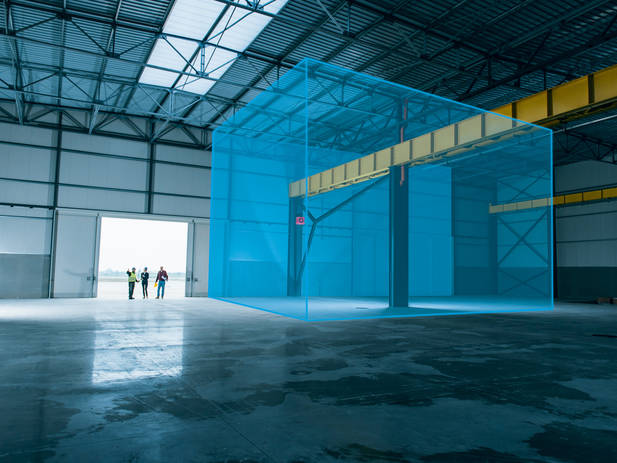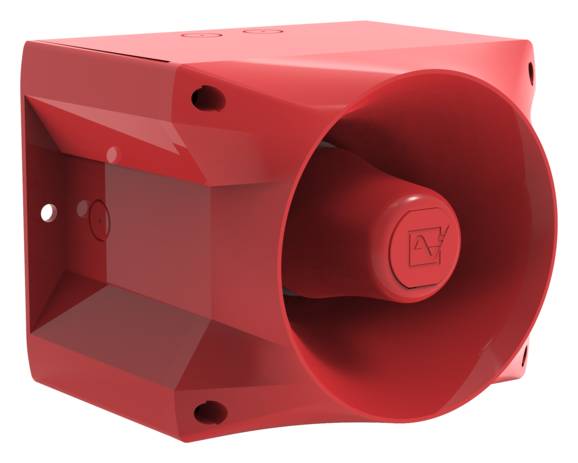Case study
Large spaces pose high risk of fire: audible fire alarm systems in logistics centres
Pfannenberg equips the distribution hub at one of world's largest online retailers with audible signaling devices.
Around 3 billion parcels are dispatched every year in Germany and with the trend rising, more and more logistics centres are being built to manage the huge numbers that will be sent in the future. Large quantities of cardboard packaging make distribution hubs extremely susceptible to fire. Planning a fire alarm system for such large spaces must take several factors into account including regional building regulations, a well-thought-out design and compliance with the VDE standard 0833-2 which has recently been updated. The following describes how to provide a safe, norm-compliant and cost-effective alarm system for a logistics centre; in this case, the electronics specialist Pfannenberg fitted the 10,000 m2 distribution hub of one of the world's leading online retailers with audible fire alarm devices.

Current norms state that the sound generated by acoustic signaling devices must exceed the ambient noise level by 10 dB(A) at all times. This often makes it difficult for planners and fire alarm specialists to determine the number of devices required to provide an alert through large spaces that will comply with standards but at the same time are cost-effective.
A typical logistics centre extends over a large floor area and has high ceilings. Wall-to-wall shelving makes it difficult for employees to perceive an alert in an emergency, such as a fire. This is why it is especially important to plan an effective signaling system which will protect at all times. The fire alarm system generally consists of a system installed throughout the building with audible or possibly visual signaling devices.
The design of a fire alarm system must provide for enough sounders to ensure that no one remains unaware of an emergency. VDE 08332 states that the sound level of the audible signaling devices used must exceed the ambient noise level by 10 dB(A) at all times. The signal must also comply with the requirements for an emergency signal defined in DIN 33404-3. However, this is what designers, installers and fire alarm system experts often find difficult: how many devices are required to provide an effective, norm-compliant and cost-effective alerting system for a large space?
Safety through visible signaling area
In this particular case, Pfannenberg, together with the system integrator, used its own "Pfannenberg 3D Coverage" planning method. This makes it possible to determine the actual coverage signaling range of audible signaling devices in relation to the height, width and length of the space. With 3D Coverage integrated in Pfannenberg's free "Pfannenberg Sizing Software" (PSS) online design tool, the electrotechnology specialist's experts were able to design the optimum signaling solution. The software calculates not only individual values but also provides an informed recommendation for suitable signaling devices and their positioning.
The calculations showed that 96 sounders of the PATROL series (PA 20 10-60DC) are required to cover the whole of the logistics centre with an ambient noise level of 85 dB(A) and that PATROL sounders with 120 dB(A) were the perfect solution for this application. They also score with their high performance in terms of signaling range and a quick and easy installation. This way, the number of sound generators required is significantly reduced compared to similar models available on the market.

Less cabling and simple installation
The installation site is also an important installation position. There are two different options: ceiling-mounted and wall- or pillar-mounted. Pillar-mounted devices were chosen for the logistics centre as Pfannenberg's calculations showed that fewer devices would be required to cover the whole space than would be the case for the ceiling-mounted option. In compliance with the relevant standards, E30 cable is used from the fire alarm system to the area in which the signal is to be heard. Conventional fire alarm system cable can be used from the first signaling device. Due to the optimal design of the devices, the number of devices required could be reduced to a minimum which leads to an additional reduction of overall costs with regard to the required total lengths of the cables.

Planning certainty saves costs
In a noisy and hectic environment such as a logistics centre, early and seriously calculated planning of the audible signaling devices is particularly important to ensure that the system is norm-compliant, safe and cost-efficient. Despite high shelving units and a significant level of ambient noise, systematic planning with the 3D Coverage method resulted in the online retailer installing a signaling solution which complies with all the relevant standards and regulations and ensures that in an emergency all the people in the large space of the logistics centre would hear an alert. Furthermore, intelligent data-based planning ensured that the fire alarm system was neither under-dimensioned (dangerous, which could lead to a non-acceptance) nor over-dimensioned (unnecessary expenses).
| Description | Language | Type | Size | Download |
|---|---|---|---|---|
Case Study "Logistic Centres"Audible fire alarm systems in logistics centres |
|
4.8 MB | Download |
